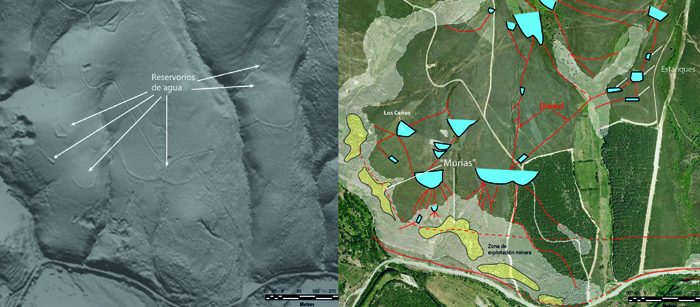26 Nov 2014
Airborne laser and GPS system reveal details of extensive workings including river redirection.
Hidden under the vegetation and crops of the Eria Valley, in León, Spain, there is a gold mining network created by the Romans two thousand years ago, as well as complex hydraulic works, such as river diversions, to divert water to the mines of the precious metal. Researchers from the University of Salamanca made the discovery from the air with an airborne laser teledetection system.
Las Médulas in León is considered to be the largest opencast goldmine of the Roman Empire, but the search for this metal extended many kilometers further south-east to the Erica river valley. Using a Light Detection and Ranging (LiDAR) laser system attached to an aircraft, the scientists discovered the ancient mining works of the area and the complex hydraulics system used by the Romans in the first century BC to extract gold. The workings include channels, reservoirs and a double river diversion,all revealed by the laser-based system.
Javier Fernández Lozano, a geologist at the University of Salamanca, commented, "Our results show that the volume of earth exploited is much greater than previously thought and the workings are impressive, having achieved actual river captures and redirects, which makes this valley extremely important in the context of Roman mining in the north-east of the Iberian Peninsula." His team's work has just been published in the Journal of Archaeological Science.
"With our images and data, we have established that the labour that went into extracting the gold until its exhaustion was so intensive that after removing the metal from surface sediments, operations continued until reaching the rocks with the auriferous quartz veins underneath."
The researcher stresses that the real discoverer was the LiDAR technology: "Unlike traditional aerial photography, this airborne laser detection system allows the visualisation of archaeological remains under vegetation cover or intensely ploughed areas".

LiDAR discovery: Ancient goldmines in the Eria river valley, Spain.
How it works
The LiDAR system comprises a laser sensor that scans the ground from an aircraft or drone with geographical references provided by GPS ground stations. The data obtained are represented by point clouds, which are processed with a piece of software to construct a cartographic model where the forms are identified, such as old reservoirs or channels.
This technology was developed by NASA in the 1960s to analyze the retreating sea ice in the Arctic and composition of the oceans. Since then their use has been extended to topography, cadastral mapping, geology and archaeology. According to the authors, the study of Roman mining in the Eria valley is the first piece of so-called geo-archaeology performed with LiDAR in Spain.
"Our intention is to continue working with this technique to learn more about mineral mining in the Roman Empire and clear up any mysteries such as why Rome abandoned such a precious resource as gold from one day to the next," Fernández Lozano concluded.About the Author
Matthew Peach is a contributing editor to optics.org.
| © 2025 SPIE Europe |
|